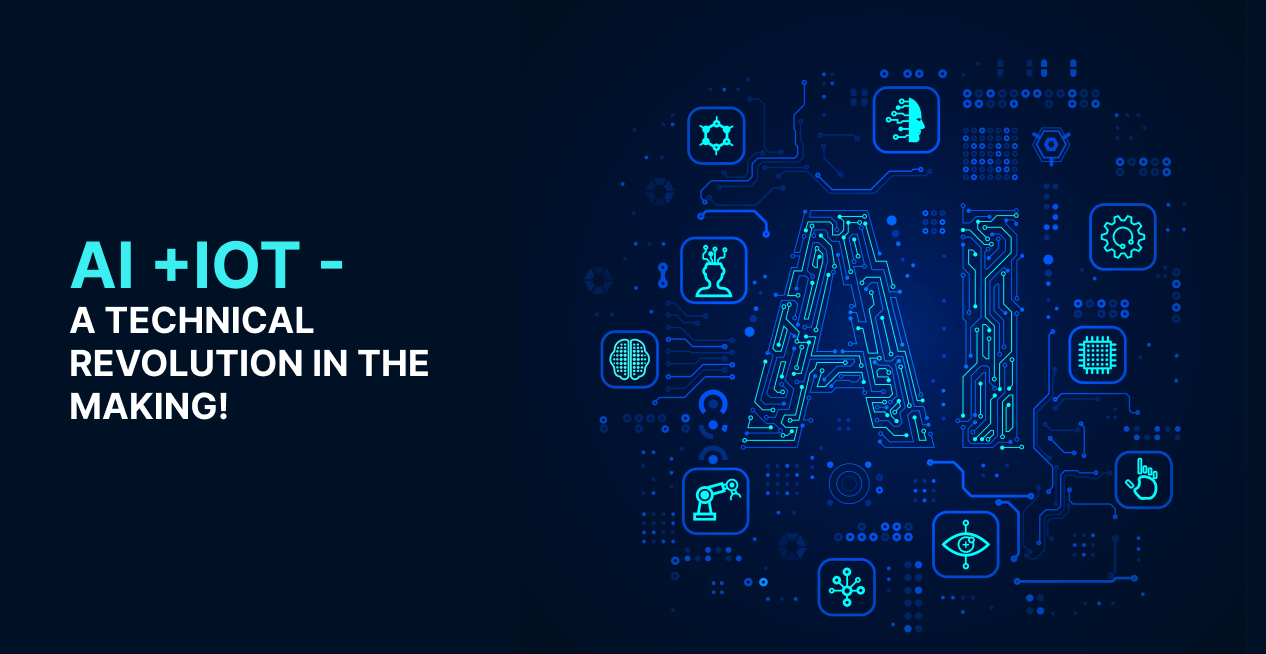Introduction
A thermostat controlled by a mobile or a fitness tracker mapping your activity are technologies one could not have imagined, twenty years before. This newfound reality consists of ‘smart household objects that are embedded with sensors, network capabilities and can share information over the internet. The Internet of Things refers to this environment of inanimate objects conversing with each other and the Internet and performing human-like functions. What is Internet of things(IoT) and Artificial Intelligence(AI) and how can they be used together? Read on to know all about this latest technological revolution.
IoT adoption in 2023
According to an IoT survey, the number of IoT connections saw an increase of almost 18% in 2022 to almost 14.3 billion active IoT endpoints. As per forecasts, 2023 is expected to see a similar rise in IoT adoption thus marking an increasing market interest in the technology. A new trend in IoT adoption is the IoT convergence with Artificial Intelligence. Before we try and understand this latest amalgamation of technologies, let’s look at the technologies individually and the benefits they bring with them,
What is AI?
Artificial Intelligence is referred to as the capabilities of the human machine to possess and exhibit human-like intelligence and decision-making capabilities. With AI techniques like Natural Language Processing, speech recognition, and Machine Vision, a machine can simulate human intelligence and decision-making. Imagine your fitness tracker suggesting meals of apt nutritional value on a day-to-day basis just as a nutritionist would. This can be achieved by understanding meal patterns, body weight, BMI, inclination toward certain foods, etc. Such technical combinations of IoT (Fitness tracker) and Generative AI and Pattern Recognition (personalized suggestions) are gaining momentum in the technical space. Here are a few types of AI commonly used in tech markets.
Narrow AI
Narrow Artificial Intelligence is a specific type of AI that is limited to performing a single function and any data collected from performing that task does not automatically go forward to other functions. Narrow AI cannot perform beyond the functionalities it is designed for and can fail in unpredictable scenarios which require humanlike instinct and decision-making. It is also known as weak AI and is the most common example of artificial intelligence in the market. Apple’s Siri is a fine example of Narrow AI that comes with predefined functions and limited use cases.
General AI
General AI usually refers to the representation of generalized human cognitive abilities in a machine. These machines when faced with unfamiliar tasks are capable of human-like results and decisions. The fundamental intention of the General AI system is to perform most human functions and is considered to be strong AI compared to narrow AI.
Super AI
Last but not least, Super AI is a type of artificial Intelligence in computers that surpasses human intelligence and human abilities. Super AI is still a hypothetical concept with no real-world application. However, if such a system were to ever exist, it would be a machine with what scientists would call, ‘consciousness’. A fictional example of the same is the famous character R2D2 from the Star Wars trilogy, a machine capable of emotions, and decision-making similar to humans and better functionalities.
What is IoT and why is it so important?
As mentioned earlier, the dependency on the network of physical items, or “things,” is increasing day by day. These things, implanted with sensors, software, and other technologies to communicate and exchange data with other devices, via the internet, are referred to as the Internet of Things (IoT), as was previously indicated. IoT gadgets include a huge variety of common domestic items from high-tech industrial gear. With more than 7 billion linked IoT devices and an expected 22 billion by 2025, demand for IoT devices is only bound to grow.
IoT has emerged in recent years as one of the most significant 21st-century technologies. Embedded devices, linked common goods including kitchen appliances, vehicles, thermostats, and baby monitors provide the best care and seamless communication to the users.
Ways AI Enhances IoT
AI can help reinvent IoT systems. While IoT systems collect and arrange data, AI can help provide creativity, decision-making skills, and driving actions for the same. It helps unlock the power of responding to queries and giving suggestions. The artificial intelligence-led IoT can enhance solutions in the following ways:
- Obtain meaningful insights and record behavioral patterns from huge data
- More accurate responses to inputs
- Protection against cyber attacks
- Providing centralized and localized intelligence
- Providing Hyper personalization along with confidentiality, data security and data privacy
Benefits of AI-Enabled IoT
Apart from a myriad of plausible applications, AI-led IoT development comes with a host of benefits for businesses. Here are a few of the ways AI-led IoT development can improve corporate workflows :
Predictive analytics and lesser risk
AI algorithms, when coupled with IoT, forecast probable failures, malfunctions, or faults by examining historical data and real-time information from IoT devices, enabling convenient maintenance while reducing downtime.
Better automation
Incorporating AI with IoT devices enables efficient automation of corporate workflows, minimizes the need for human interventions, and ensures optimal usage of resources. This particular attribute can save up to thousands of dollars spent on manpower and resources by a company.
Optimized resource utilization
AI-enabled by analyzing consumption trends and adjusting to decreasing waste and expenses, IoT can optimize the use of resources like electricity, water, and raw materials.
Increased productivity and higher efficiency
AI-integrated IoT systems reduce inefficiencies, simplify processes, and optimize workflows to boost output and make better use of available resources.
Hyper personalization
Based on information from IoT devices, AI examines user behavior and preferences to provide individualized experiences, such as custom suggestions, goods, and services.
Real-time monitoring and control
IoT systems with AI capabilities provide real-time monitoring and management of several processes and devices. These systems send out timely warnings enabling prompt action in contingencies.
Revamped customer experiences
AI can analyze customer data from IoT devices to deliver better customer experiences through targeted marketing, personalized support, and enhanced product offerings.
Advanced Security
In IoT networks, AI helps discover abnormalities and potential security breaches, assisting in the rapid identification and response of cyber threats amidst other safety concerns.
Healthcare advancements
AI-enabled IoT devices can be used in healthcare applications for remote patient monitoring, early disease detection, and personalized treatment plans, leading to improved patient outcomes.
Environmental sustainability
IoT systems equipped with AI are very efficient when it comes to environmental monitoring and management. This in turn helps address ecological challenges, conserve resources, and reduce environmental impacts.
IoT and AI examples in action
AIoT is seeing popularity in various industries and finding applications in day to day lives of the consumer. A few popular examples of AIoT in technical space include:
Smart Retail
Consumer identification, product preferences, facial recognition, target audience detection, and targeted ads are a few ways AIoT is being applied in retailing and customer service.
Drone Traffic Monitoring and Drone Firefighting
Thermal Signatures reading, Traffic monitoring, and congestion detection can make the best of IoT in public transport management.
Corporate Workspaces:
Corporate Workspaces are now implementing AI-led IoT systems which can detect the number of personnel present and regulate temperature & electricity accordingly. This practice is saving businesses thousands, if not millions of dollars annually.
Fleet Management in Supply Chains
A Lot of companies are improving their fleet management and opting for AIoT to monitor the health condition of fleet vehicles, reduce fuel costs, track vehicles, and identify unsafe driver behavior.
Robotics and Manufacturing
Almost all manufacturing industries are opting for AI robots and smart objects to reduce personnel and overhead costs.
With new technologically advanced AIoT solutions cropping up, AI-led IoT systems are finding more and more applications day by day. Apart from the mentioned above, there are many such software systems and objects that are reaching mainstream markets much faster than anticipated.
Conclusion
Businesses must realize the hidden potential of AIoT systems and use it best to their advantage. From automating their workflows with AI tracking systems to implementing smart systems for better corporate workspaces, businesses can save huge amounts of money, resources, and manpower in the long run. IoT application development and AI development services are high ROI avenues that businesses are heavily investing in. It not only yields high ROI but also keeps companies at par with the everchanging technologically advanced market scenarios.










